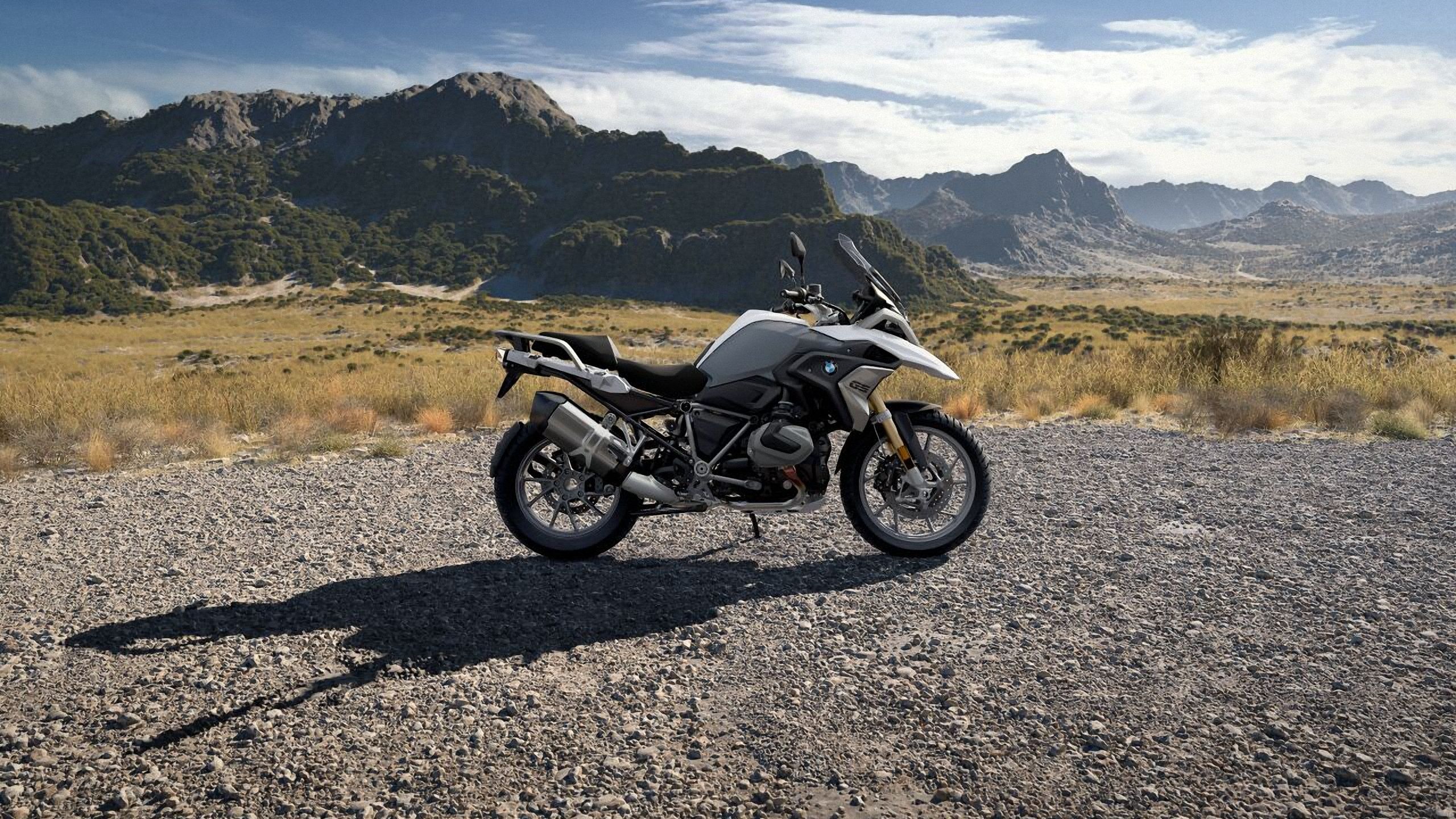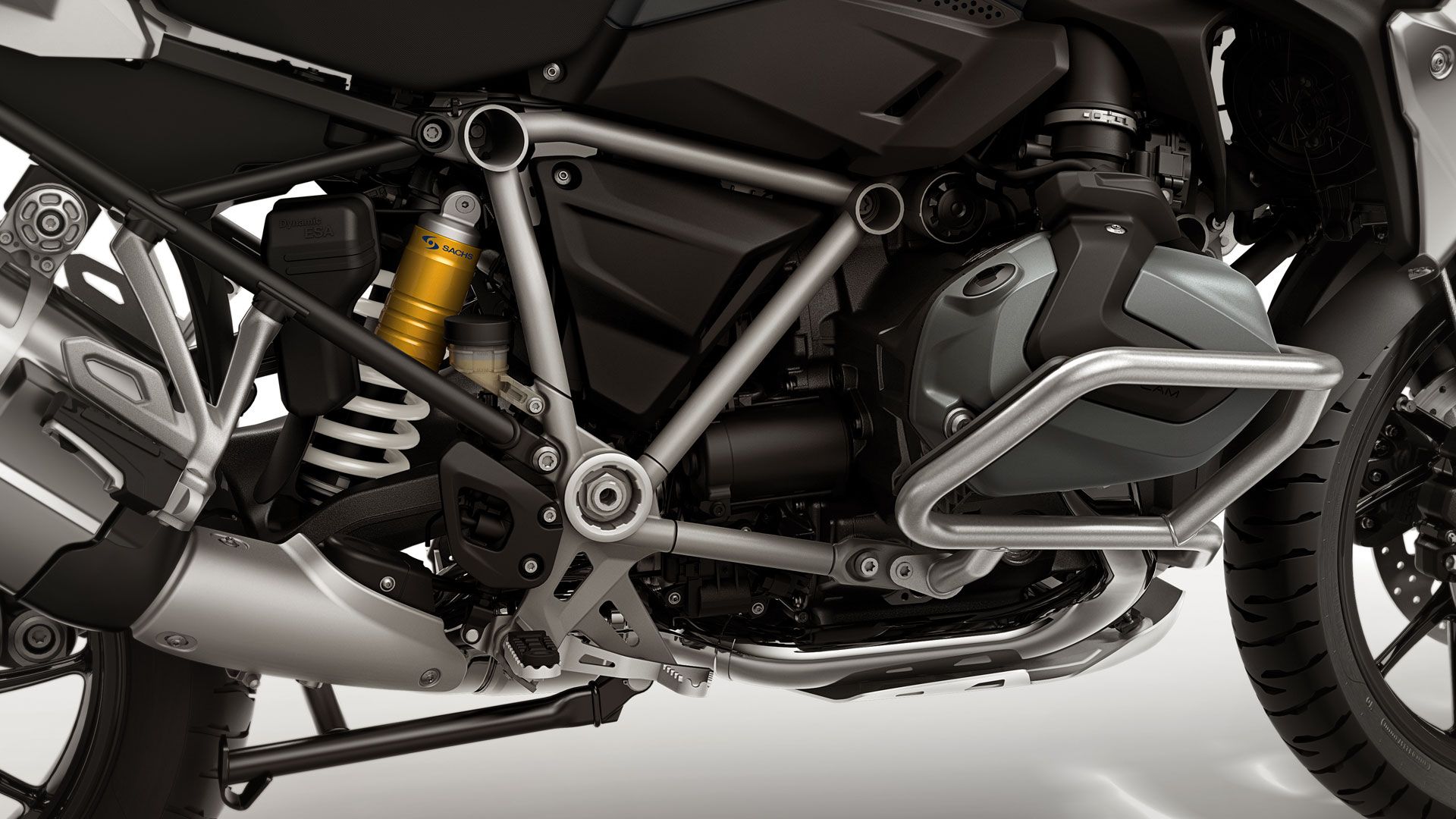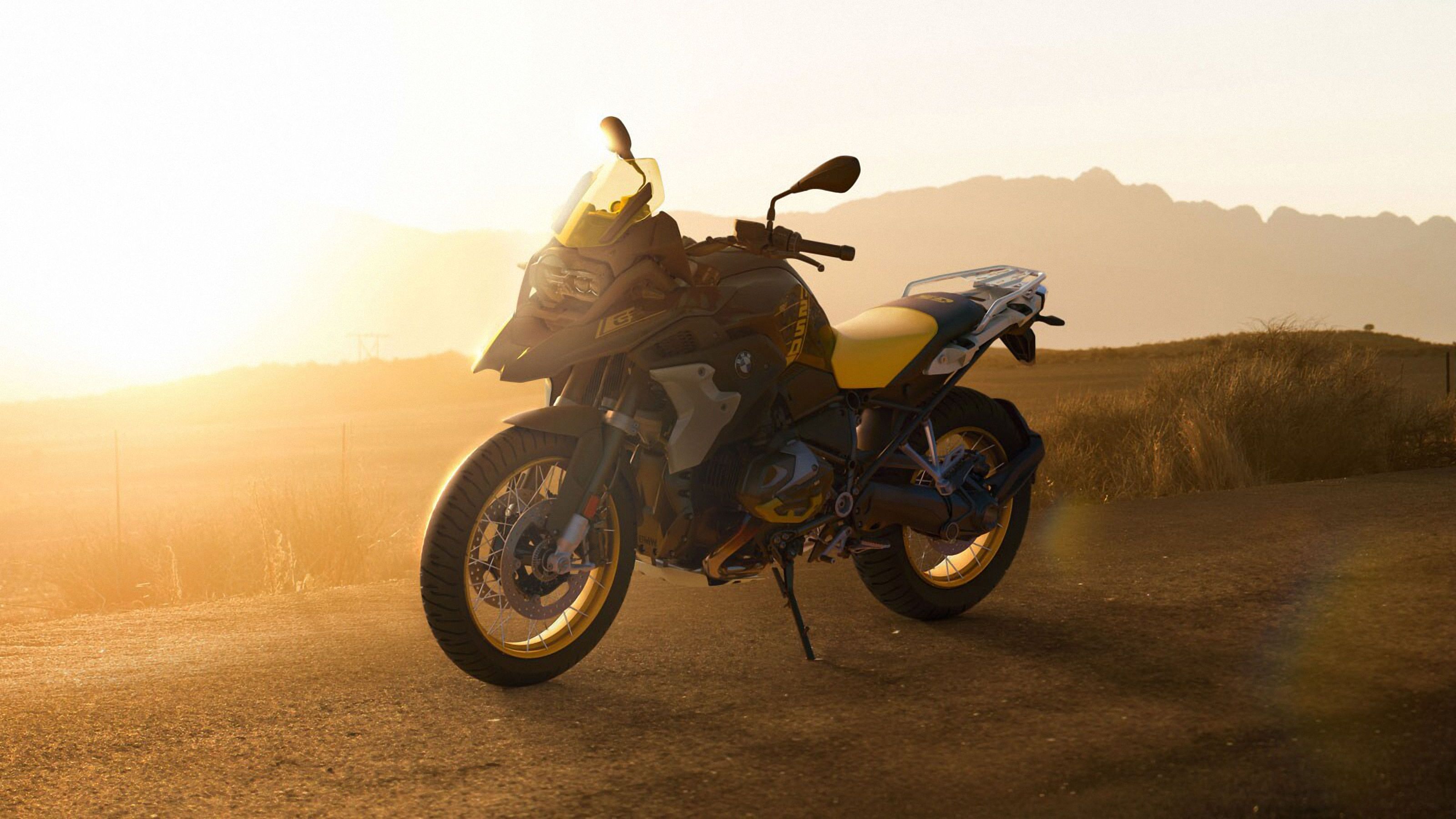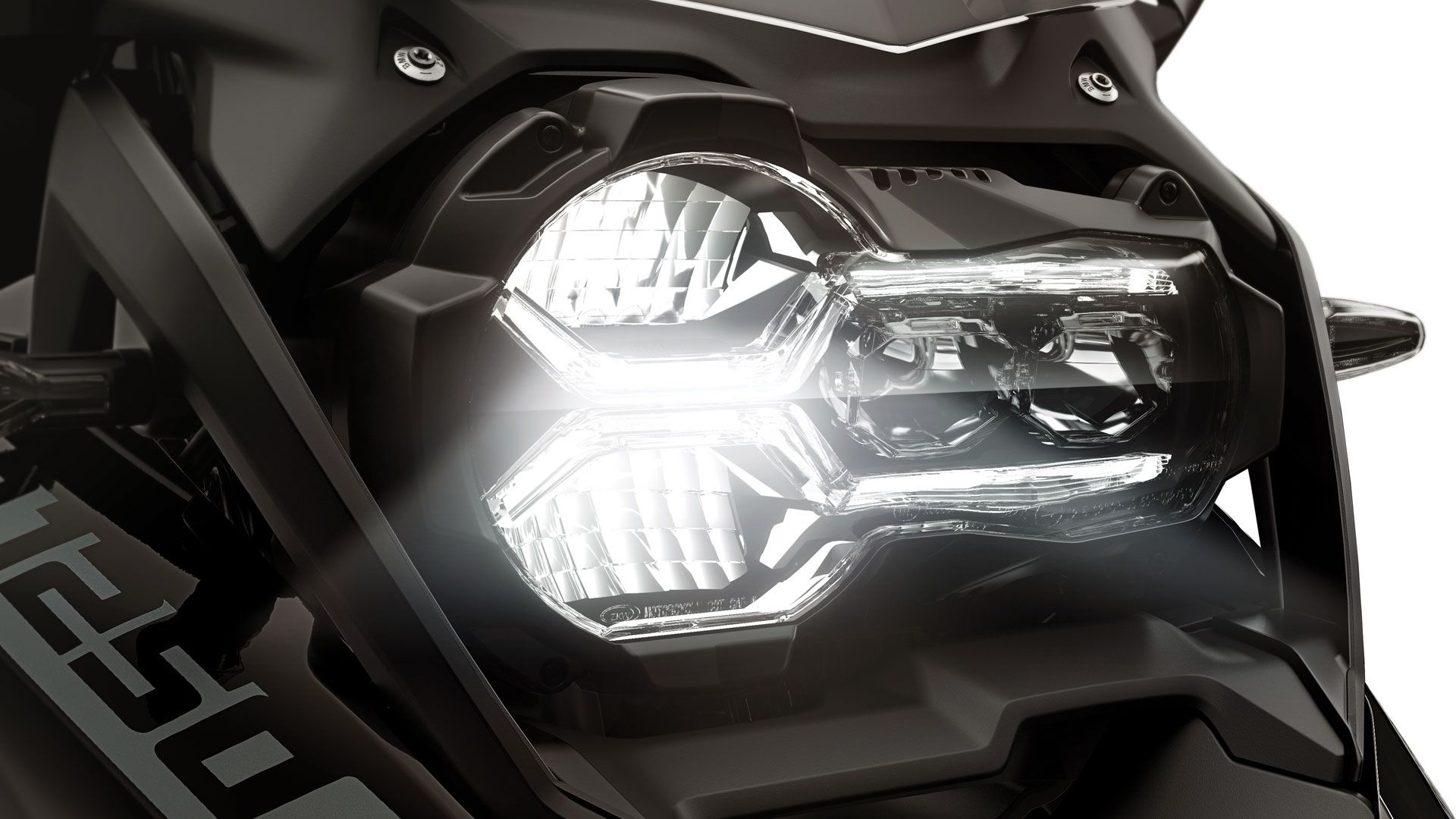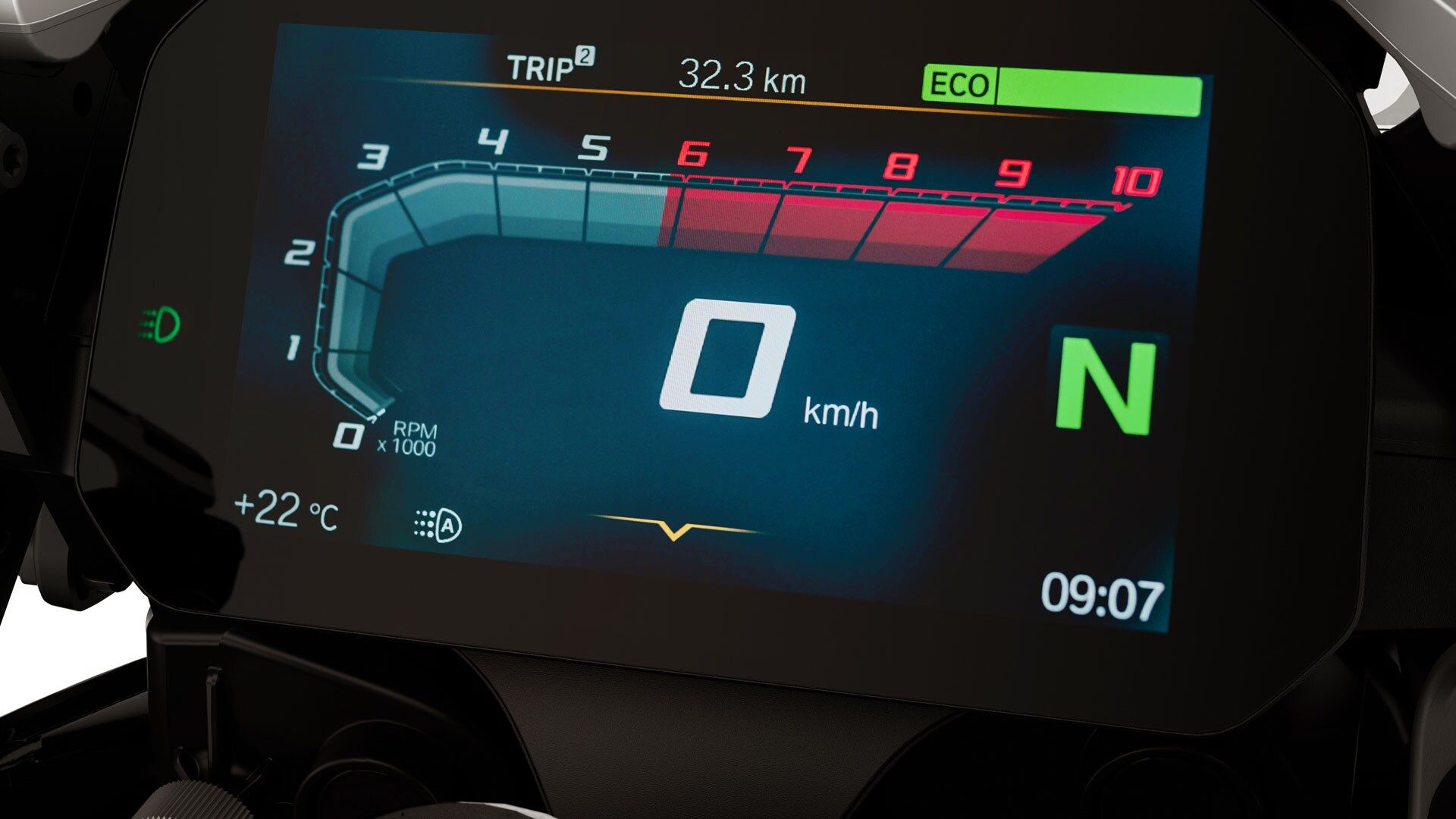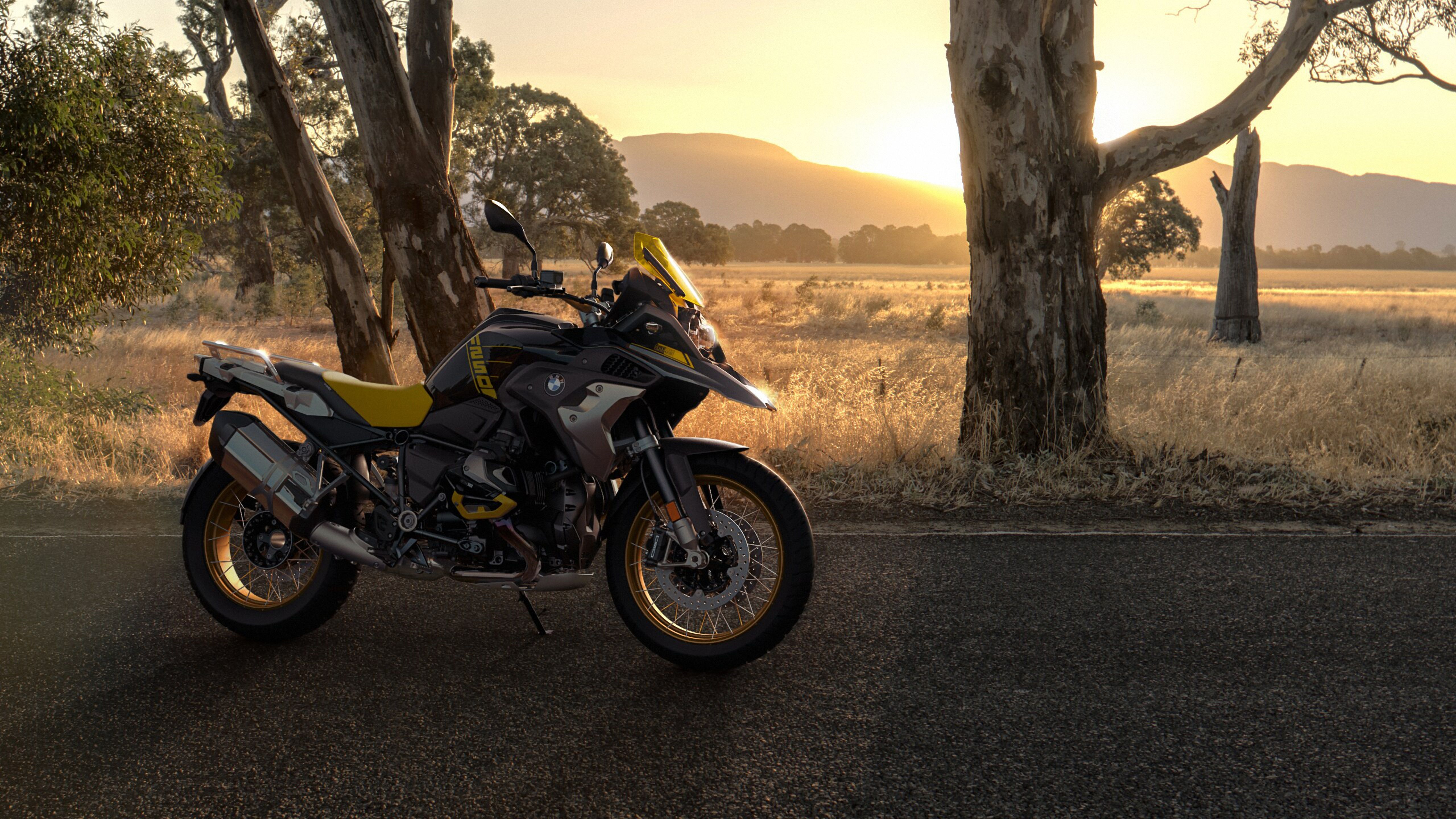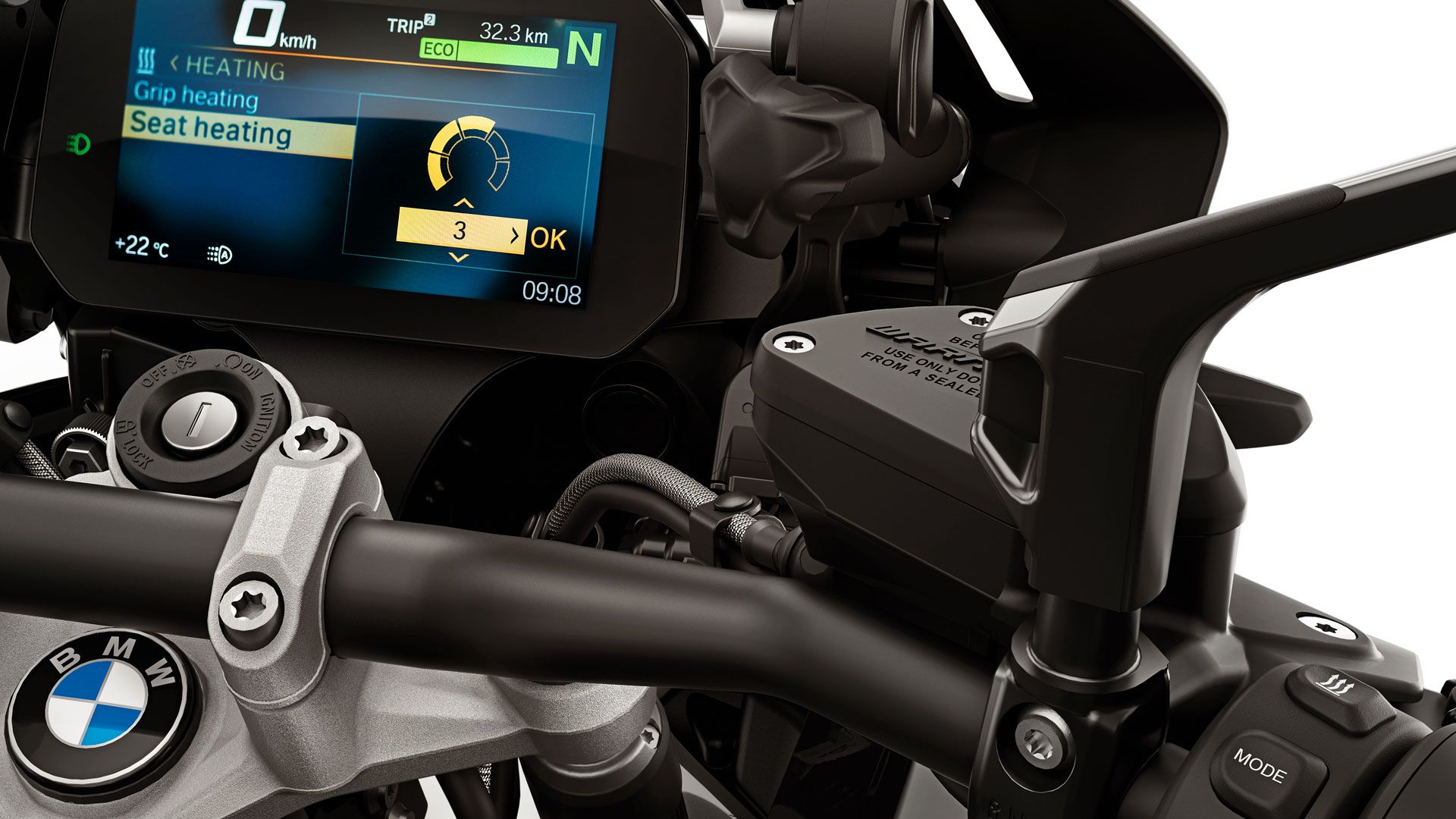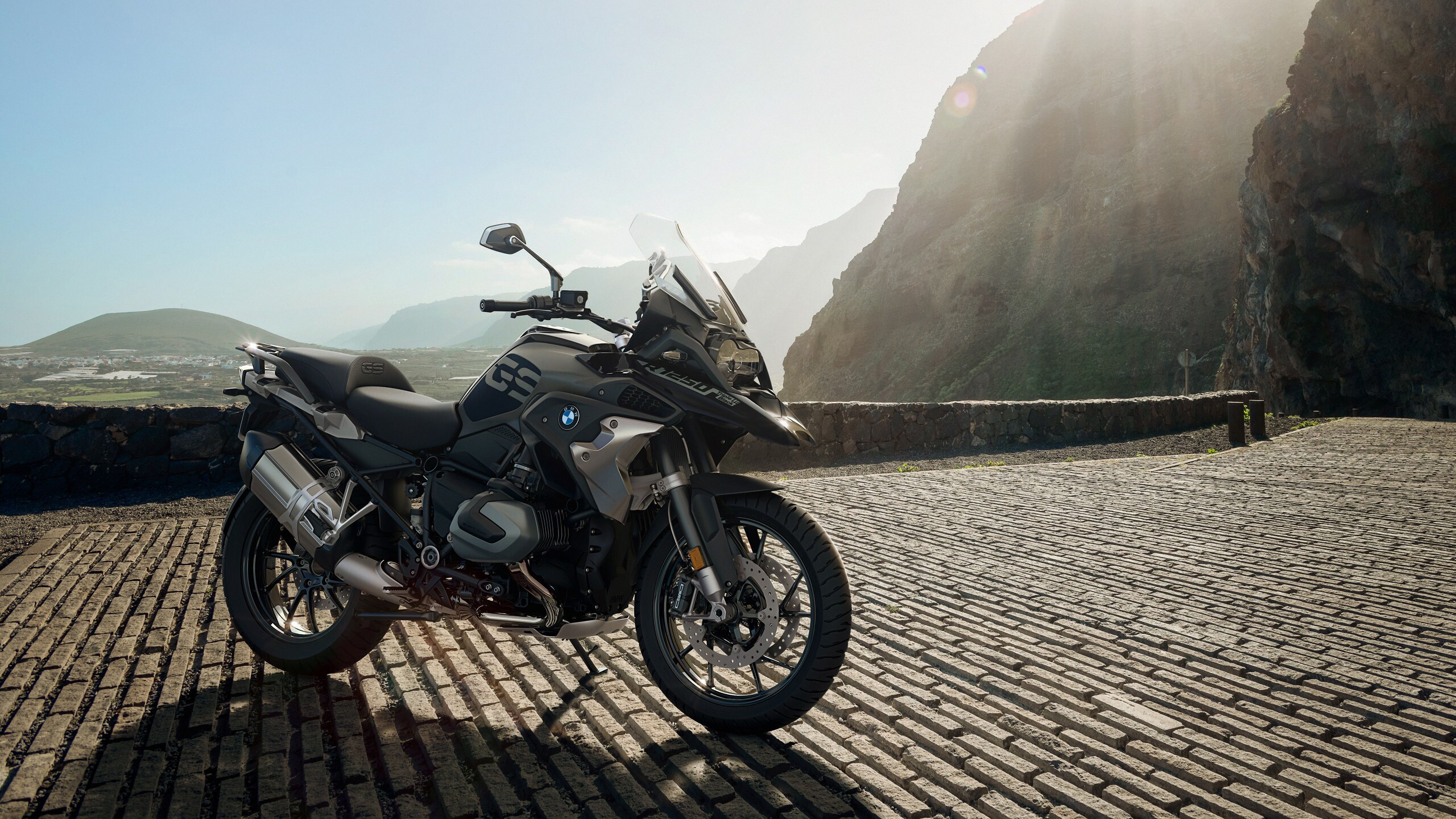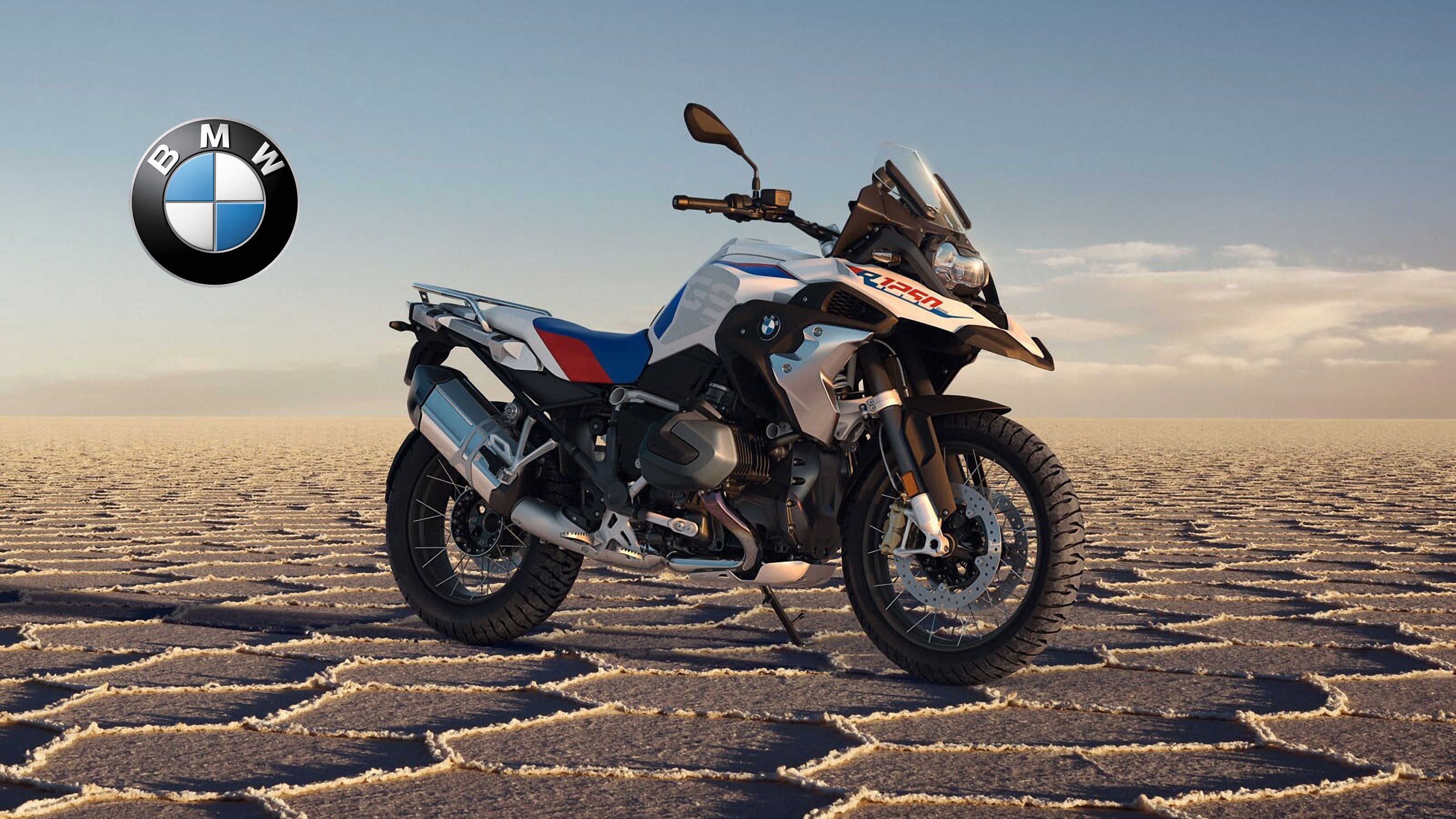BMW launched into MY2021 with a freshly updated R 1250 GS base model accompanied by a 40th year anniversary model that sports the Option 719 “bumblebee” livery. The boxer-twin powerplant remains the same mechanically but comes with improved ride-control and safety electronics along with some long-requested optional comfort gear and a full line of ex-werke accessory equipment to boot. BMW brings its on- and off-road experience together to make a truly capable globetrotter, and decidedly not the two-wheeled equivalent of a soccer mom's SUV.
BMW R 1250 GS Performance and Capability
Much like Harley's V-twin and Ducati's L-twin, it's hard to imagine an engine more representative of Beemer's own history than the Boxer engine. This flat-twin mill on the R 1250 GS runs with the heads and jugs sticking out of both sides where it gets plenty of air moving across the cooling fins to supplement the liquid-cooling system. While this leaves the top-ends somewhat exposed to fall damage, there's just no arguing with success I suppose, and there's no doubt that this is a popular engine design at the end of the day.
Within those outboard valve covers resides a pair of camshafts and a balance shaft to take some of the sting out of the engine vibes, plus there's Beemer's proprietary ShiftCam system that rotates the cam independent from its drive gear to change the valve timing and deepen the torque well.
Massively oversquare, the boxer-twin runs a 102.5 mm bore and short, 76 mm stroke for a 1,254 cc total displacement and a speecy-spicy 12.5-to-1 compression ratio that will demand top-octane road champagne to prevent damage from knock and ping. That may be inconvenient in some areas, but it's the price you pay for all that power.
What kind of power are we looking at? Well, the broadened torque band maxes out at 6,250 rpm with 105 pounds of grunt on tap, and the power comes in with 136 ponies at 7,750 rpm. Strong, helical-cut gears quietly transmit the power through the six-speed gearbox with a slipper clutch to couple engine power to the tranny and provide some anti-hop protection at the rear wheel. The factory claims an R 1250 GS top speed of “over 124 mph,” which even if that's a little ambitious, it's still way too fast for public roads, you know, unless you're on the Autobahn or something.
|
Engine & Drivetrain |
|
|
Engine: |
Air/liquid-cooled four stroke flat twin engine, double overhead camshaft, one balance shaft and variable engine timing system BMW ShiftCam. |
|
Bore x Stroke: |
102.5 mm x 76 mm |
|
Displacement: |
1,254 cc |
|
Rated output: |
136 hp @ 7,750 rpm |
|
Max. torque: |
105 lb-ft @ 6,250 rpm |
|
Compression ratio: |
12.5 : 1 |
|
Fuel preparation: |
Electronic intake manifold injection |
|
Emission control: |
Regulated three-way catalytic converter, compliant with EU5 emission standard |
|
Clutch: |
Wet clutch with an anti-hopping function, hydraulic activation |
|
Gearbox: |
Constant mesh 6-speed gearbox with helical gear teeth |
|
Drive: |
Shaft drive |
Design
There's a lot going on with this Gelände/Straße model right out of the gate. A cut down front fender on the R 1250 GS rides under a bird's beak for double protection up front, just the thing if you're riding in inclement weather or on loose surfaces. Though there are no exposed inner fork tubes down low, the fender uprights maintain a foil shape to shunt air pressure away from the forks for low-drag penetration.
A wildly asymmetrical, LED headlight rocks DRLs to make you more visible in the daylight and comes with a dynamic lean-sensitive feature that puts the pool of light into the turn where you need it most. Even the blinkers are hot stuff with a new LED construction and multi-function capabilities. Up front, the outside perimeter of LEDs acts as position lamps in both daytime and the dark, while the emitters in the middle serve as the turn signals independent from the border. Out back, the blinkers take on an additional third function as brake lights to make you even more visible from the rear in conjunction with the above two features, and at both ends the turn signals ride tucked up out of harm's way.
There's one last tidbit to consider with the lights. They go through a “welcome” series in the beginning and a “goodbye” routine at the end of your ride, plus you can have the headlight stay on after the bike shuts down to illuminate your way into your parking area.
The windshield comes well vented with a definite scoop at the top edge to punch a hole in the weather for you. A color TFT screen bundles all of the pertinents together in one location behind the protection of the screen and fairing. The handlebar comes stock with short risers, but if you shop in the Big-n-Tall section, there's a set of accessory risers that will jack the bar upwards by a whopping 30 mm (1.18-inch) that will open up the top of the rider's triangle and leave plenty of room if you want to stand on the pegs whilst riding off-road.
The 5.2-gallon fuel tank contributes its considerable hump to the flyline and carries plenty of fuel for globetrotting, trailblazing, or just commuting/touring. A deep swale cradles the pilot's tukas at 33.5 inches off the deck, though there's an optional lower set of suspension components that can move that down to as low as 31.5 inches high which is still pretty tall for short riders, but is low for the genre.
As a result of customer requests, the factory offers heated seats and grips as an accessory with five heat settings for the pilot and two heat levels for the pillion. Substantial J.C. rails meet in back to form up a small luggage rack above another low-high fender arrangement similar to up front with an upswept muffler to prevent terrain strikes on the silencers.
|
Dimensions & Capacities |
|
|
Wheelbase: |
59.6" (1,514 mm) |
|
Seat height: |
33.5" / 33.3" (850 mm / 870 mm) (OE lowered suspension 31.5" / 32.3" - 800 mm / 820 mm) |
|
Inner leg curve: |
1,870 mm / 1,910 mm (OE lowered suspension 1,750 mm / 1,790 mm) |
|
Fuel capacity: |
5.2 gallons with approx. 1.1 gallons reserve |
|
Length (over mud guard): |
86.9" (2,207 mm) |
|
Height (over windshield): |
56.3" (1,430 mm) |
|
Wide (over hand guard): |
37.5" (952.5 mm) |
|
Unladen weight, road ready, (fully fueled): |
549 lbs (249 kg) |
|
Permitted total weight: |
1,025 lbs (465 kg) |
|
Payload (with standard equipment): |
476 lbs (216 kg) |
|
Maximum speed: |
over 124 mph |
|
Fuel type: |
Premium Unleaded |
Chassis
A two-part frame on the R 1250 GS makes up the standing structure with the engine as a stressed unit to complete the assembly and achieve its final rigidity. The forward section establishes a rake angle of 25.7-degrees with an even 4 inches of trail over a 59.6-inch wheelbase to put the R 1250 GS in decidedly nimble company. Out back, another frame section bolts to the boxer to support the seating and single-side, cast-aluminum swingarm that doubles as a housing for the shaft-type final drive.
The engineers over at the Bayerische Motoren Werke have their own ideas about suspension, and that bears out in the 37 mm Motorrad Telelever front forks that rely on a central spring strut for support and damping action. It's an unusual setup to be sure, but it separates the steering load from the suspension load for a difference you'll definitely feel in the handlebar.
The front is non-adjustable but the rear WAD strut delivers travel-driven damping along with a handwheel for both the spring preload tweak and the rebound-damping adjustment, so you can dial in the rear end at least. Suspension travel paints a picture of a capable off-road machine with 7.5 inches of travel up front opposite 7.9 inches at the rear wheel, and that'll soak up some terrain for sure.
The stock hoops are good for both street and soft terrain in a 120/70-19 ahead of a 170/60-17. Dual, four-piston calipers bite 305 mm front discs opposite a 276 mm disc and twin-pot anchor, and at both ends the lean-sensitive ABS feature helps keep you between the stripes and rubber-side down. A Hill Start Control feature comes stock to allow for safer take-offs on inclines by holding the brake for you so you can deploy both of your Lamborfeeties for stability.
|
Chassis & Suspension |
|
|
Frame: |
Two-section frame, front- and bolted on rear frame, load-bearing engine |
|
Front suspension/ Travel: |
BMW Motorrad Telelever; stanchion diameter 1.5" (37 mm), central spring strut/ 7.5" (190 mm) |
|
Rear suspension/ Travel: |
Cast aluminum single-sided swing arm with BMW Motorrad Paralever; WAD strut (travel-related damping), spring pre-load hydraulically adjustable (continuously variable) at handwheel, rebound damping adjustable at handwheel/ 7.9" (200 mm) |
|
Caster: |
4.0" (100.6 mm) |
|
Steering head angle: |
64.3° |
|
Wheels: |
Cast aluminum wheels |
|
Wheel, front: |
3.00 x 19“ |
|
Wheel, rear: |
4.50 x 17“ |
|
Tire, front: |
120/70 R 19 |
|
Tire, rear: |
170/60 R 17 |
|
Brake, front: |
Dual 305 mm floating discs, 4-piston radial calipers |
|
Brake, rear: |
276 mm disc, double-piston floating caliper |
|
ABS: |
BMW Motorrad Integral ABS Pro (part-integral, slant-layer-optimized) |
BMW R 1250 GS Pricing
The base-model R 1250 GS starts out at $17,995 MSRP. You can get it shot in Black Storm Metallic/Black/Agate Gray, Light White Non-Metallic, or the red/white/blue Style Rallye. If homage pieces are more your style, the Option 719 Edition 40 Years GS starts out at $19,745 MSRP, and it comes painted in the distinctive black and yellow borrowed from the historical R 100 GS model.
|
Pricing & Equipment |
Standard equipment:
- TFT color display with connectivity
- Full-LED headlight, DTC (Dynamic Traction Control)
- Integral ABS Pro (inclination-optimized ABS)
- 3 Ride Modes (ECO, Rain and Road)
- HSC (Hill Start Control)
- USB charging socket
Optional equipment:
- Dynamic ESA (Electronic Suspension Adjustment with automatic load leveling and automatic damping mode)
- Seat heating (rider and passenger)
- Enduro-Package (with engine guard and handlebar riser)
- Option 719 milled parts
- Ride Modes
- Pro, Rallye, and Triple Black style variants
|
Color: |
Black Storm Metallic/Black/Agate Gray, Light White Non-metallic, Light white/Racing Blue Metallic/Racing Red, Edition 40 Years GS (yellow/black) |
|
Price: |
$17,995, Edition 40 Years: $19,745 |
Competitors
BMW puts together a solid product that can go toe-to-toe with any marque around the world, so it deserves a top-drawer competitor, enter the Ducati Multistrada V4.
Ducati Multistrada V4
Coming off a fresh update, the “V4” pretty much breaks even in the electronics department with a robust suite of its own that includes Power Modes, Riding Modes, Cornering ABS, and Wheelie Control. The Beemer, however, rocks a Hill Start assist that holds the brake for you so you can deploy both of your Lamborfeeties for stability on an incline, but the trade off there is the Ducati's Quick Shift feature.
Ducati really brings the pain with a cutting-edge radar system. The system monitors your blind spots and enables an adaptive cruise-control feature to maintain a given following distance automatically. Ouch.
As for the looks, well, Ducati is a tough act to follow with its raw passion and sensual curves, and the V4 is no exception though BMW hits many of the same design high notes. Not sayin' the GS is ugly, just that the V4 is just that doggone good looking. Ouch again.
Things get even worse for Beemer in the stems; Duc sends its V4 out with semi-active electronic suspension control, something for which BMW has no equal on its R 1250 GS. The V4's beating heart packs 1,158 cc with DOHC and four-valve heads over each of its cylinders. It puts out a smokin'-hot 170 horsepower to beat the socks off the Beemer in brute power with a torque trade off that has Duc at 92 pound-feet versus 105 pounds o' grunt from the GS.
Ducati's paint selection lack imagination. The new Multistrada V4 comes only in Ducati Red over black with white trim. It rolls for $19,995, so the extra yummygoodness is not without cost, and I leave it to the individual to choose between the two based on personal needs, taste, and especially budget.
He Said
“BMW's entry takes a beating against the Ducati, it's true, but that doesn't diminish what the R 1250 GS has going on. Not even a little bit. There is room for improvement though. The stock equipment could include heated seats and grips, and a set of panniers would boost its utility right off the showroom floor. Oh well, there's always next year.”
She Said
My wife and fellow motorcycle writer, Allyn Hinton, says, “The new 40-year edition is quite the tourer. It has updated tech, including new riders modes, a six-axis IMU, and features that are optional on the base model, such as heated seats and handgrips along with the new adaptive headlights. It's the base model with everything thrown in except some serious off-road tires, which is fine for most adventure trips, but for your own Long Way 'Round you'll want to spring for the optional tires.”
Further Reading
BMW Motorrad
Read more BMW news.


